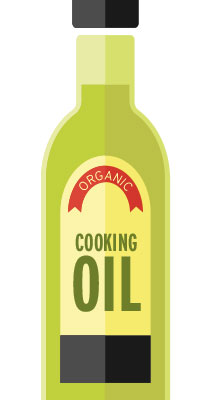Anatomy of a cooking oil label
This article was originally published in May 2015
From avocado to olive to pumpkin seed oil, you’ll find dozens of cooking oils on our shelves at PCC. Knowing which oil to select when, and understanding the many different labels and terms used to identify these oils, can be confusing. We’ve compiled a basic glossary of terms to help you out.

Unrefined
Unrefined oils have more intense flavor profiles, darker colors and are less resistant to heat. They’re best used as finishing/drizzling oils, rather than for cooking.
Refined
Refined oils have a more neutral flavor and are good choices for higher heat cooking. They’ve been heated to remove solids, gums, resins, sterols and some vitamins in the oils.
Expeller pressed
Expeller pressed oils are pressed using only physical (mechanical) pressure; no heat or chemicals are applied during the extraction process.
High oleic
High oleic oils contain oleic acid, a monounsaturated fatty acid found in olive oil. Sunflower and safflower oils are traditionally high in polyunsaturated fatty acids, making them unstable at high temperatures. The presence of oleic acid makes them better suited for high-heat cooking.
Smoke point
Smoke point is often listed on oils to help prevent you from heating your oil too high, which results in bad taste and unhealthy, oxidized fats.
Nutrition facts panel
Nutrition facts panel is required to list total fat, saturated fat, and trans fat. And many oils also list the amount of monounsaturated (MUFA) and polyunsaturated (PUFA) fatty acids.
- MUFAs are believed to be the most heart healthy of the fats; this is the type of fat found in olive oil. With the exception of olive oil, most MUFA-rich oils are good options for cooking because they are less susceptible to oxidation during cooking.
- PUFAs include the two essential fatty acids: omega 3 and omega 6. Generally, PUFA-rich oils are not good for high-heat cooking but grapeseed oil is an exception to this rule.
- Saturated fats are solid at room temperature and often are avoided because they raise LDL (“bad” cholesterol). New evidence is questioning the impact of saturated fats on heart health, especially coconut oil, which raises HDL (“good” cholesterol levels).
What to avoid
Anything with “hydrogenated” or “partially hydrogenated” in the list of ingredients. These are often found in margarines and baking products like Crisco.
“Vegetable oil” means the product was made from the cheapest oil available when it was produced. Most likely this will be GMO canola, cottonseed or soybean oil.
If the oil is NOT labeled as either extra virgin, cold pressed or expeller pressed then it was produced with heat and chemicals such as hexane, which can extract more oil from raw materials but results in poor-quality oils.
